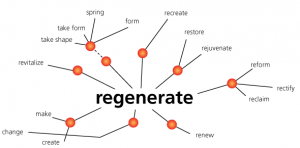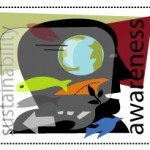The Greening of Educational Institutions
When we began to build the collection of EarthSayers.tv, we reviewed many videos featuring professors and students from colleges around the world, mostly addressing issues of how to make their living, learning, and working spaces more sustainable. It was how I became aware of the growing movement of “greening” campus operations and endowment practices. The Sustainable Endowments Institute publishes The College Sustainability Report Card and is the only  independent evaluation of campus and endowment sustainability activities at colleges and universities in the United States and Canada. The rationale behind investing in this report card is the same reason many companies are touting their green initiatives: “Colleges are now taking pride in greener campuses and sustainability-savvy investments—increasingly important concerns for parents and students in choosing a school…They can find the first comprehensive college sustainability selection tool at GreenReportCard.org.”
independent evaluation of campus and endowment sustainability activities at colleges and universities in the United States and Canada. The rationale behind investing in this report card is the same reason many companies are touting their green initiatives: “Colleges are now taking pride in greener campuses and sustainability-savvy investments—increasingly important concerns for parents and students in choosing a school…They can find the first comprehensive college sustainability selection tool at GreenReportCard.org.”
Sustainability Research and Curriculum
At the same time, I was seeing on EarthSayers.tv many colleges addressing the academic side of sustainability with courses and programs such as Harvard’s Program in Sustainability and Environmental Management and Portland State University’s (PSU) Graduate Certificate in Sustainability, an integrated series of post-baccalaureate courses that comprise a multidisciplinary study of the environmental, social, and economic dimensions of sustainability.
This interdisciplinary approach is called out in a recently enacted Higher Education Opportunity Act of 2008 (HR 4137) which included the University Sustainability Program (USP). Under this Act, individual institutions are eligible for funding to “integrate sustainability curriculum in all programs of instruction, particularly in business, architecture, technology, manufacturing, engineering, and science programs.” At the original intended authorization level of $50 million, USP will annually support between 25 and 200 sustainability projects as reported by the Campaign for Environmental Literacy.
This growth of the academic side of Sustainability is tracked by the Association for the Advancement of Sustainability in Higher Education (AASHE). AASHE is an association of colleges and universities working to create a sustainable future. The AASHE notes “from the creation of 70+ sustainability-focused academic programs compared to 27 in the Digest in 2007 and the hiring of 57 new sustainability faculty, to the opening of 13 sustainability-themed research centers and nearly triple that number in the planning stages, it is clear that curricular transformation is underway in the academy.” They expect a big boost in numbers and activities given funding of the University Sustainability Program at the Department of Education.
Now that I have relocated EarthSayers.tv and myself to Portland, Oregon from San Francisco, I am taking the opportunity to become more involved in the education side of sustainability. While having worked for the last twenty plus years for corporations, including my own for the last fifteen years, a high tech direct marketing agency, I wanted my understanding and experience with sustainability to be more integrated encompassing education and government as well as business.
 So for grounding purposes and to help in any way I can with marketing and communications, I have begun working with the Social Sustainability Network at PSU. The Network is a funded project by the Miller Foundation to develop an infrastructure to support and extend social sustainability work and make a tangible and critical difference in the world. “The focus is on truly integrating the academy and the community; and theory, research, and practice” says Network organizer, Marion Sharp. Of particular interest to me is a colloquium series co-sponsored by the Center of Professional Integrity & Accountability. Jesse Dillard is the Center’s Director and Retzlaff Chair, Accounting, and a professor of accounting who introduced me to the Network and has been very helpful in introducing me to faculty and staff members.
So for grounding purposes and to help in any way I can with marketing and communications, I have begun working with the Social Sustainability Network at PSU. The Network is a funded project by the Miller Foundation to develop an infrastructure to support and extend social sustainability work and make a tangible and critical difference in the world. “The focus is on truly integrating the academy and the community; and theory, research, and practice” says Network organizer, Marion Sharp. Of particular interest to me is a colloquium series co-sponsored by the Center of Professional Integrity & Accountability. Jesse Dillard is the Center’s Director and Retzlaff Chair, Accounting, and a professor of accounting who introduced me to the Network and has been very helpful in introducing me to faculty and staff members.
In upcoming posts I will be reporting back the work of the Network, the Center, and other sustainability-related programs at Portland State University. This week the School of Business Administration and the Center for Global Leadership in Sustainability is sponsoring the 3rd Annual International Conference on Business and Sustainability, November 5 and 6, 2009. The theme of this year’s conference is regenerate. We hope to include some of the content in EarthSayers.tv, the voices of sustainability.

November 5th and 6th, 2009
 A small group of us had the opportunity this past week to meet with Sam Nelson visiting Portland from Australia thanks to the folks at Transition PDX. Sam is the co-founder of the Maia Maia Project, an innovative community based Emissions Reduction Currency System. He is also an owner of Greenbase, a business in Australia that provides emissions accounting services for over half the mining industry there, and is the past Director of a sustainable biofuels company based in London and India.
A small group of us had the opportunity this past week to meet with Sam Nelson visiting Portland from Australia thanks to the folks at Transition PDX. Sam is the co-founder of the Maia Maia Project, an innovative community based Emissions Reduction Currency System. He is also an owner of Greenbase, a business in Australia that provides emissions accounting services for over half the mining industry there, and is the past Director of a sustainable biofuels company based in London and India.





 The content map identifies four major elements of sustainability – Systemic Change, Planet, People, Prosperity – with twenty-three categories under these four elements. All keywords and phrases roll up to one of the elements e.g. consumerism (keyword) to culture and consciousness (category) to people (element).
The content map identifies four major elements of sustainability – Systemic Change, Planet, People, Prosperity – with twenty-three categories under these four elements. All keywords and phrases roll up to one of the elements e.g. consumerism (keyword) to culture and consciousness (category) to people (element).

